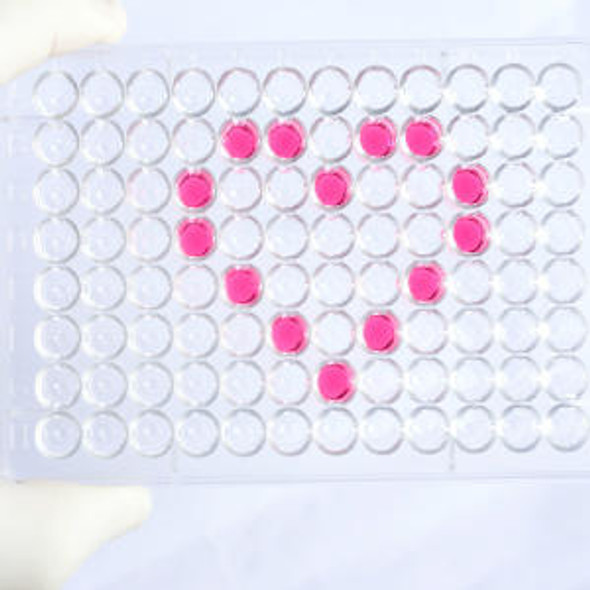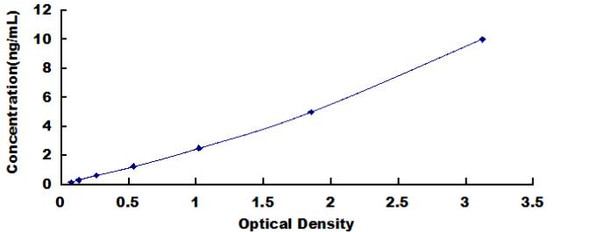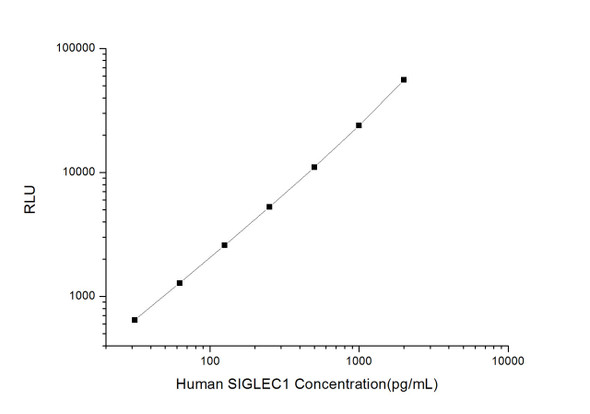Human Immunology ELISA Kits 1
Human SIGLEC10 (Sialic Acid Binding Ig Like Lectin 10) CLIA Kit (HUES00763)
- SKU:
- HUES00763
- Product Type:
- ELISA Kit
- ELISA Type:
- CLIA Kit
- Size:
- 96 Assays
- Sensitivity:
- 18.75pg/mL
- Range:
- 31.25-2000pg/mL
- ELISA Type:
- Sandwich
- Reactivity:
- Human
- Sample Type:
- Serum, plasma and other biological fluids
- Research Area:
- Immunology
Description
| Assay type: | Sandwich |
| Format: | 96T |
| Assay time: | 4.5h |
| Reactivity: | Human |
| Detection method: | Chemiluminescence |
| Detection range: | 31.25-2000 pg/mL |
| Sensitivity: | 18.75 pg/mL |
| Sample volume: | 100µL |
| Sample type: | Serum, plasma and other biological fluids |
| Repeatability: | CV < 15% |
| Specificity: | This kit recognizes Human SIGLEC10 in samples. No significant cross-reactivity or interference between Human SIGLEC10 and analogues was observed. |
This kit uses Sandwich-CLIA as the method. The micro CLIA plate provided in this kit has been pre-coated with an antibody specific to Human SIGLEC10. Standards or samples are added to the appropriate micro CLIA plate wells and combined with the specific antibody. Then a biotinylated detection antibody specific for Human SIGLEC10 and Avidin-Horseradish Peroxidase (HRP) conjugate are added to each micro plate well successively and incubated. Free components are washed away. The substrate solution is added to each well. Only those wells that contain Human SIGLEC10, biotinylated detection antibody and Avidin-HRP conjugate will appear fluorescence. The Relative light unit (RLU) value is measured spectrophotometrically by the Chemiluminescence immunoassay analyzer. The RLU value is positively associated with the concentration of Human SIGLEC10. The concentration of Human SIGLEC10 in the samples can be calculated by comparing the RLU of the samples to the standard curve.
| UniProt Protein Function: | Siglec-10: a cell surface protein belonging to the immunoglobulin superfamily and the SIGLEC (sialic acid binding Ig-like lectin) family. Most SIGLECs have 1 or more cytoplasmic immune receptor tyrosine-based inhibitory motifs, or ITIMs. Putative adhesion molecule that mediates sialic-acid dependent binding to cells. Preferentially binds to alpha2,3- or 2,6-linked sialic acid. The sialic acid recognition site may be masked by cis interactions with sialic acids on the same cell surface. SIGLECs are typically expressed on cells of the innate immune system, with the exception of the B-cell expressed SIGLEC6. In the immune response, may act as an inhibitory receptor upon ligand induced tyrosine phosphorylation by recruiting cytoplasmic phosphatase(s) via their SH2 domain(s) that block signal transduction through dephosphorylation of signaling molecules. Five alternatively spliced isoforms have been described. |
| UniProt Protein Details: | Protein type:Cell adhesion; Membrane protein, integral Chromosomal Location of Human Ortholog: 19q13. 3 |
| NCBI Summary: | SIGLECs are members of the immunoglobulin superfamily that are expressed on the cell surface. Most SIGLECs have 1 or more cytoplasmic immune receptor tyrosine-based inhibitory motifs, or ITIMs. SIGLECs are typically expressed on cells of the innate immune system, with the exception of the B-cell expressed SIGLEC6 (MIM 604405). [supplied by OMIM, Jul 2002] |
| UniProt Code: | Q96LC7 |
| NCBI GenInfo Identifier: | 118572721 |
| NCBI Gene ID: | 89790 |
| NCBI Accession: | Q96LC7. 3 |
| UniProt Secondary Accession: | Q96LC7,Q3MIR5, Q6UXI8, Q96G54, Q96LC8, A8K1I5, A8K3C7 C9JJ33, C9JM10, F8W917, |
| UniProt Related Accession: | Q96LC7 |
| Molecular Weight: | 57,486 Da |
| NCBI Full Name: | Sialic acid-binding Ig-like lectin 10 |
| NCBI Synonym Full Names: | sialic acid binding Ig like lectin 10 |
| NCBI Official Symbol: | SIGLEC10 |
| NCBI Official Synonym Symbols: | SLG2; PRO940; SIGLEC-10 |
| NCBI Protein Information: | sialic acid-binding Ig-like lectin 10 |
| UniProt Protein Name: | Sialic acid-binding Ig-like lectin 10 |
| UniProt Synonym Protein Names: | Siglec-like protein 2 |
| Protein Family: | Sialic acid-binding Ig-like lectin |
| UniProt Gene Name: | SIGLEC10 |
| UniProt Entry Name: | SIG10_HUMAN |
As the RLU values of the standard curve may vary according to the conditions of the actual assay performance (e. g. operator, pipetting technique, washing technique or temperature effects), the operator should establish a standard curve for each test. Typical standard curve and data is provided below for reference only.
| Concentration (pg/mL) | RLU | Average | Corrected |
| 2000 | 52089 59353 | 55721 | 55693 |
| 1000 | 23625 24323 | 23974 | 23946 |
| 500 | 11216 10848 | 11032 | 11004 |
| 250 | 4825 5763 | 5294 | 5266 |
| 125 | 2702 2514 | 2608 | 2580 |
| 62.5 | 1400 1222 | 1311 | 1283 |
| 31.25 | 642 706 | 674 | 646 |
| 0 | 27 29 | 28 | -- |
Precision
Intra-assay Precision (Precision within an assay): 3 samples with low, mid range and high level Human SIGLEC10 were tested 20 times on one plate, respectively.
Inter-assay Precision (Precision between assays): 3 samples with low, mid range and high level Human SIGLEC10 were tested on 3 different plates, 20 replicates in each plate.
| Intra-assay Precision | Inter-assay Precision | |||||
| Sample | 1 | 2 | 3 | 1 | 2 | 3 |
| n | 20 | 20 | 20 | 20 | 20 | 20 |
| Mean (pg/mL) | 94.27 | 262.01 | 713.42 | 102.29 | 244.63 | 697.67 |
| Standard deviation | 10.13 | 23.66 | 50.94 | 11.68 | 27.25 | 77.86 |
| C V (%) | 10.75 | 9.03 | 7.14 | 11.42 | 11.14 | 11.16 |
Recovery
The recovery of Human SIGLEC10 spiked at three different levels in samples throughout the range of the assay was evaluated in various matrices.
| Sample Type | Range (%) | Average Recovery (%) |
| Serum (n=5) | 98-112 | 106 |
| EDTA plasma (n=5) | 86-99 | 93 |
| Cell culture media (n=5) | 97-114 | 105 |
Linearity
Samples were spiked with high concentrations of Human SIGLEC10 and diluted with Reference Standard & Sample Diluent to produce samples with values within the range of the assay.
| Serum (n=5) | EDTA plasma (n=5) | Cell culture media (n=5) | ||
| 1:2 | Range (%) | 99-114 | 102-118 | 88-100 |
| Average (%) | 107 | 108 | 95 | |
| 1:4 | Range (%) | 92-104 | 86-99 | 103-115 |
| Average (%) | 99 | 91 | 109 | |
| 1:8 | Range (%) | 88-100 | 85-98 | 93-103 |
| Average (%) | 93 | 91 | 98 | |
| 1:16 | Range (%) | 100-119 | 91-101 | 94-112 |
| Average (%) | 108 | 96 | 102 |
An unopened kit can be stored at 4°C for 1 month. If the kit is not used within 1 month, store the items separately according to the following conditions once the kit is received.
| Item | Specifications | Storage |
| Micro CLIA Plate(Dismountable) | 8 wells ×12 strips | -20°C, 6 months |
| Reference Standard | 2 vials | |
| Concentrated Biotinylated Detection Ab (100×) | 1 vial, 120 µL | |
| Concentrated HRP Conjugate (100×) | 1 vial, 120 µL | -20°C(shading light), 6 months |
| Reference Standard & Sample Diluent | 1 vial, 20 mL | 4°C, 6 months |
| Biotinylated Detection Ab Diluent | 1 vial, 14 mL | |
| HRP Conjugate Diluent | 1 vial, 14 mL | |
| Concentrated Wash Buffer (25×) | 1 vial, 30 mL | |
| Substrate Reagent A | 1 vial, 5 mL | 4°C (shading light) |
| Substrate Reagent B | 1 vial, 5 mL | 4°C (shading light) |
| Plate Sealer | 5 pieces | |
| Product Description | 1 copy | |
| Certificate of Analysis | 1 copy |
- Set standard, test sample and control (zero) wells on the pre-coated plate and record theirpositions. It is recommended to measure each standard and sample in duplicate. Note: addall solutions to the bottom of the plate wells while avoiding contact with the well walls. Ensuresolutions do not foam when adding to the wells.
- Aliquot 100µl of standard solutions into the standard wells.
- Add 100µl of Sample / Standard dilution buffer into the control (zero) well.
- Add 100µl of properly diluted sample (serum, plasma, tissue homogenates and otherbiological fluids. ) into test sample wells.
- Cover the plate with the sealer provided in the kit and incubate for 90 min at 37°C.
- Aspirate the liquid from each well, do not wash. Immediately add 100µL of BiotinylatedDetection Ab working solution to each well. Cover the plate with a plate seal and gently mix. Incubate for 1 hour at 37°C.
- Aspirate or decant the solution from the plate and add 350µL of wash buffer to each welland incubate for 1-2 minutes at room temperature. Aspirate the solution from each well andclap the plate on absorbent filter paper to dry. Repeat this process 3 times. Note: a microplatewasher can be used in this step and other wash steps.
- Add 100µL of HRP Conjugate working solution to each well. Cover with a plate seal andincubate for 30 min at 37°C.
- Aspirate or decant the solution from each well. Repeat the wash process for five times asconducted in step 7.
- Add 100µL of Substrate mixture solution to each well. Cover with a new plate seal andincubate for no more than 5 min at 37°C. Protect the plate from light.
- Determine the RLU value of each well immediately.






